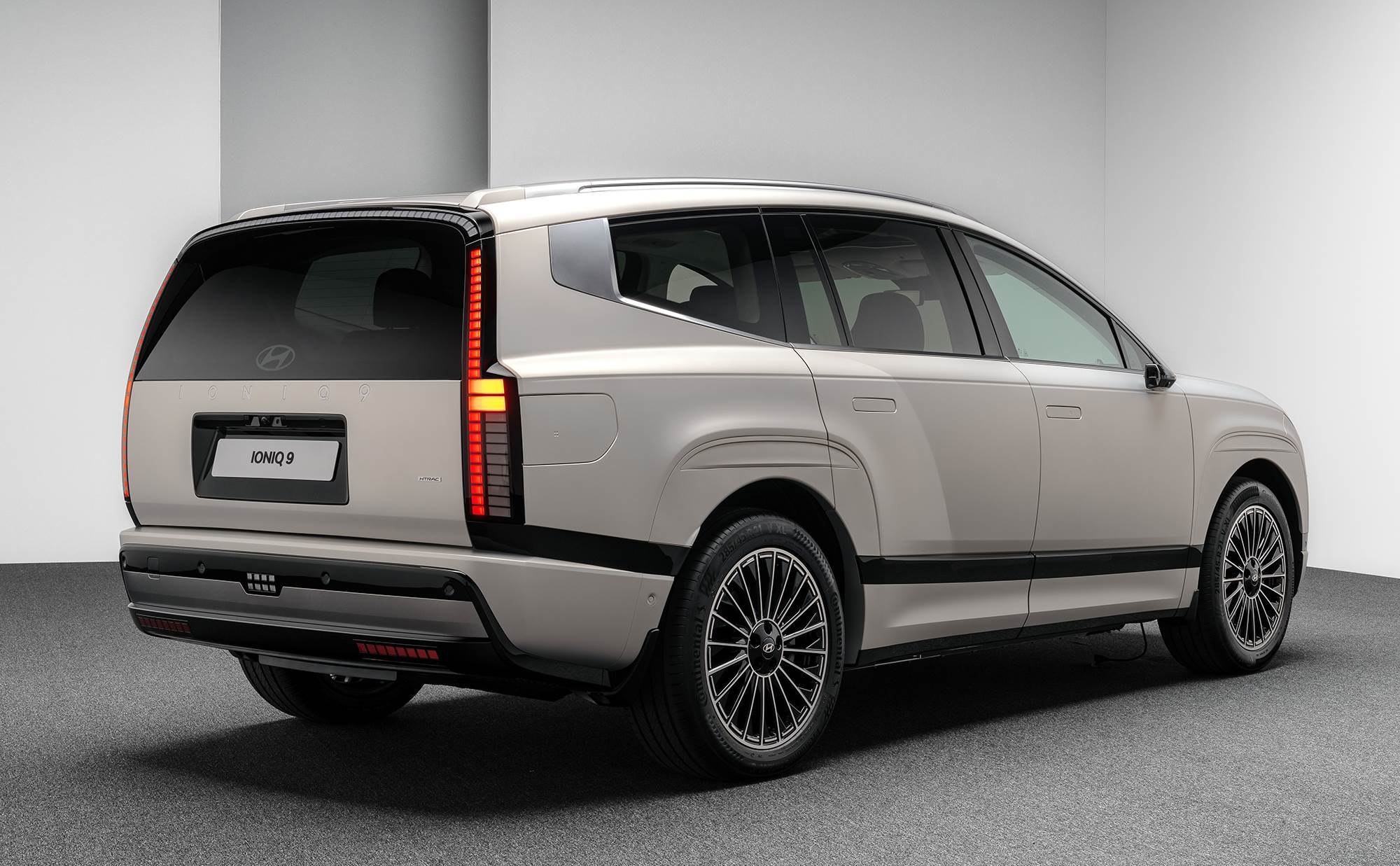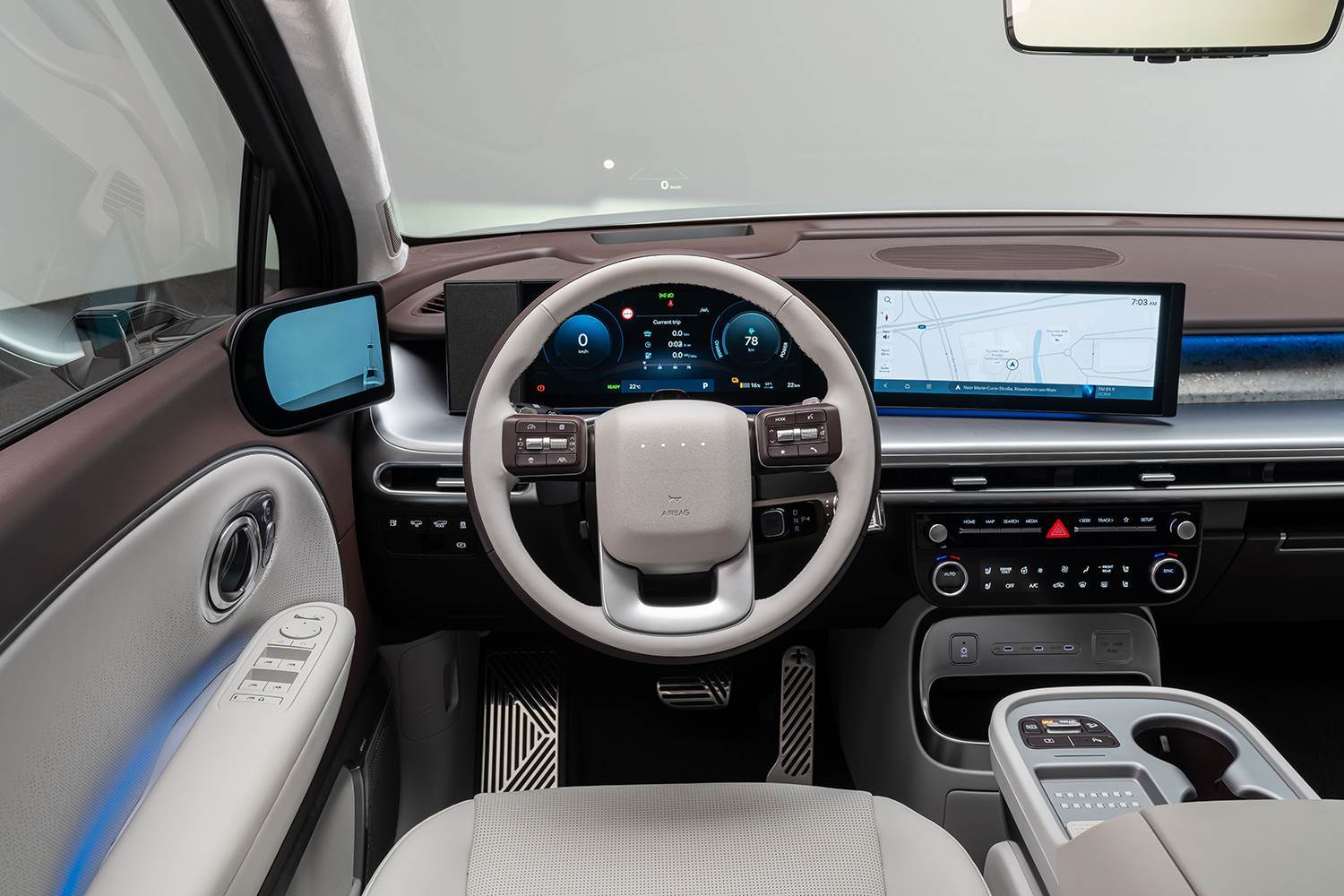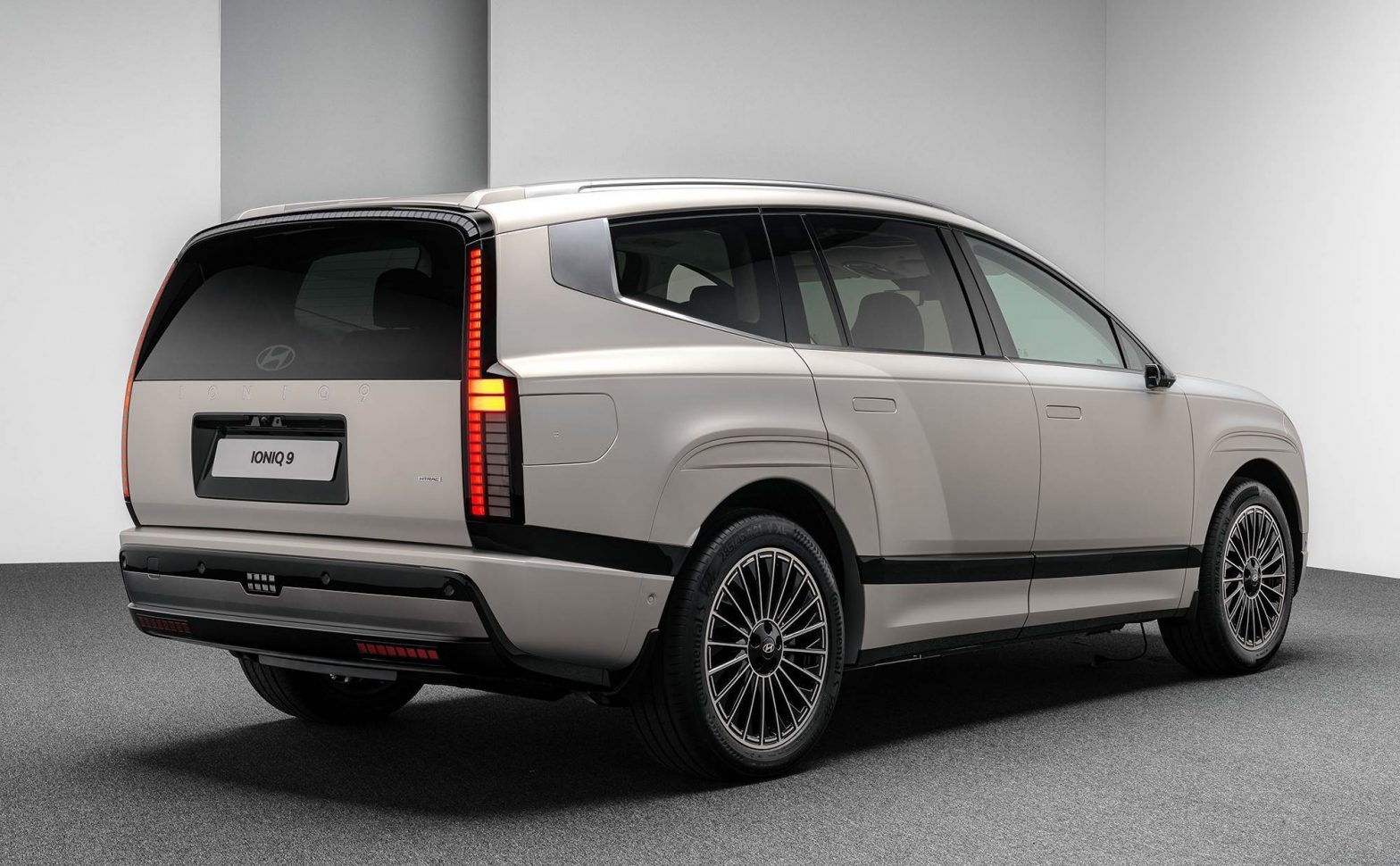Hyundai Motor Company has taken the covers off the Ioniq 9, its largest, most luxurious and longest-legged electric car yet, taking the fight to the Volvo EX90 with seven seats, up to 429bhp and a maximum range of 385 miles / 616 kilometres.
The flagship of Hyundai’s expanding Ioniq range of bespoke EVs shares its E-GMP platform with the Ioniq 5 crossover and Ioniq 6 saloon, and will take the brand into unprecedented territory with a top-end price tag approaching £80,000.
It was revealed at the Los Angeles motor show last week, the same event where in 2021 Hyundai previewed its bold design cues, lounge-like interior and sleek, aero-optimised bodywork with the futuristic Seven concept. Like its Ioniq range-mates, the 9 stays largely true to the show car that preceded it, retaining its unusual tapered cabin, heavily raked roof, bluff rear end and optionally swivelling middle-row seats.
Apart from the Seven’s reverse-opening doors and rear sofa, though, one notable element the production car does not keep is the concept’s name, having been rebranded as the 9 during development to make space for smaller Ioniq 7 and 8 models below – though Hyundai remains tight-lipped on what these will look like or when they will arrive.
The Ioniq 9’s California debut is emblematic of its prevailing focus on the American market, where much of its development has taken place, building on the success of the similarly positioned, ICE-powered Hyundai Palisade SUV, launched in 2019. Nonetheless, the Ioniq 9 is a global car and will be a close rival to the similarly sized Volvo EX90, Mercedes-Benz EQS SUV and Kia EV9 – to which it is closely related – when it lands in the UK around the middle of 2025.

As the firm’s most overtly premium-focused model yet, the Ioniq 9 has a significant role to play in attracting conquest custom to Hyundai from established upmarket brands like Audi and BMW. Design boss Simon Loasby was confident it can serve this purpose, telling Autocar that the Ioniq 9 is emblematic of Hyundai’s drastic shift in positioning and perception in recent years: “For the amount of money you’re spending, you’re getting an incredibly premium car. People would argue that Hyundai isn’t premium, but when you see what you get, and the quality of execution and the technical content, even the [new entry EV] Inster is a premium car. Hyundai has gone from being a white goods manufacturer, as one journalist said of the Ioniq 6, to one of emotional, desirable, attractive, high-quality vehicles.”
Loasby even went so far as to suggest there is potential for the Ioniq 9 to make a dent in the full-bore luxury segment. When asked if he expects even Range Rover owners to be tempted into making the switch, he said: “Absolutely. I could see a big band of people being tempted, and I can see a band of people saying absolutely not, as well. That’s okay.”

Hyundai Ioniq 9 powertrains
The Ioniq 9 will be available from launch with three choices of powertrain. The 215bhp, rear-driven Long-Range car is the most efficient and claims the headline 385-mile projected maximum range figure, while the 308bhp dual-motor car returns 320 miles per charge and the top-rung AWD Performance model, with 429bhp, manages 311 miles. They get from 0-62mph in 9.4, 6.7 and 5.2sec respectively, and top out at 124mph.
As with Ioniqs 5 and 6, the large new SUV is in line for a hot N variant.
Each variant is equipped with an 800V, 110.3kWh (usable capacity) battery, which is the largest fitted to any EV on sale in the UK, edging those of even the Mercedes-Benz EQS and Rolls-Royce Spectre. It’s rated to charge at speeds of up to 350kW, though as with other E-GMP-based EVs currently on sale, Hyundai suggests the real-world maximum will be closer to 220-230kW.
The battery can also be used to charge external devices with the 230V vehicle-to-load function, and Hyundai has made some subtle improvements to “address common EV customer concerns”, such as improving the consistency of the battery’s performance, providing more detailed energy usage information and enhancing the inbuilt EV route planner.
Other important upgrades for the Ioniq 9 are the introduction of a higher gear ratio at the rear for increased torque at lower speeds, and a two-stage power inverter that is said to improve efficiency.
 Hyundai Ioniq 9 design
Hyundai Ioniq 9 design
Hyundai refers to the Ioniq 9 as an ‘aerosthetic lounge’, coining a phrase that reflects the design team’s simultaneous focus on desirability, aerodynamic efficiency and interior refinement.
In keeping with Hyundai’s ‘chess piece’ approach to differentiating each of its models, it is only subtly visually related to its electric range-mates – chiefly through the liberal use of ‘parametric’ pixel lighting designs, which frame the tailgate and wrap around the front end – though as full-width headlights are banned in the UK, cars in this country will have two separate headlight clusters.
Loasby says its “Teutonic” silhouette (influenced, as it was, by aircraft fuselages) is “not typical for an SUV”, acknowledging the similarities with traditional estate car designs – chiefly in the bluff rear end and relatively flat roof and window line.
Impressively for a car of this size and shape, the Ioniq 9 touts a drag coefficient of as little as 0.259 – far more slippery than its Kia and Volvo rivals and on a par with even some low-slung saloons. The rounded front end, minimalist surfacing and various air-channelling design elements are key contributors, but Hyundai highlights the Ioniq 9’s unusual tapered ‘boat-tail’ rear end as a defining design characteristic.
The Ioniq 9 also has a dual-motion active air flap in its undertray to manage air passing underneath – a first for Hyundai – along with new wind-cheating wheel designs and ‘hidden’ antennae to minimise obstructions.
The overhangs are minimised and the A-pillars are placed as far forward as possible for maximum cabin space in all dimensions, resulting in a 3130mm wheelbase that outstrips the Land Rover Defender 110.

Hyundai Ioniq 9 interior
Available either with seven seats or a pair of swivelling middle-row armchairs in the VIP-focused six-seater, the Ioniq 9’s cabin aims to serve as what Loasby calls a “natural lounge” – “a furnished, relaxed, caring space”, majoring on airiness and functionality.
It has the longest wheelbase of any Hyundai yet, at 3130mm, allowing it to offer highly competitive levels of leg room in all three rows – Hyundai quotes up to 2050mm for the second and third rows combined – and for the optional middle-row armchairs to fully recline.
The cockpit is familiar from the other Ioniq models, with a one-piece panoramic curved panel mounted atop the dashboard for the driver display and infotainment screens, but a healthy smattering of physical buttons and switches left in place for key controls.
The Ioniq 9’s centre console – dubbed ‘Universal Island 2.0’ – has a ‘hidden’ 12.6-litre storage cubby underneath the 5.6-litre top tray, and the whole unit slides back and forth to free up space in the front of the cabin and give rear passengers easier access.
Out back, the Ioniq 9 touts up to 1323 litres of boot space with the third row folded flat – 200 litres more than a Land Rover Discovery – and 620 litres with seats up. In addition, it has one of the largest ‘frunks’ of any EV in the UK, with up to 88 litres of space beneath the bonnet (52 in the AWD car).
 Hyundai Ioniq 9 chassis
Hyundai Ioniq 9 chassis
The Ioniq 9 has been tuned for an optimum blend of long-distance refinement and smooth, predictable handling, claims Hyundai, emphasising the lengths to which its engineers have gone to minimise weight, and touting the dynamic benefits of full torque vectoring and a new suspension system that has been “designed specifically for EVs and SUVs”.
The Ioniq 9 has multi-link suspension at each end, self-levelling twin-valve dampers to keep the body flat in corners and hydro-bushing components to reduce vibration on the move. It does not have rear steering like some other cars of this size but is expected to match the EV9’s 12.4-metre turning circle, which is only slightly wider than that of the much smaller Hyundai Tucson.
With sound-absorbing foam in the tyres, acoustic glass, reinforcement of key structures and an active sound control system that can “isolate noise at the source”, Hyundai says the Ioniq 9 has NVH levels in keeping with its premium billing – and in line with some bona fide luxury cars.
